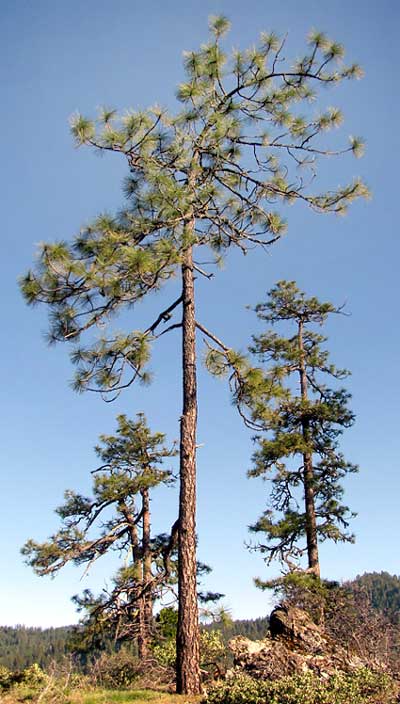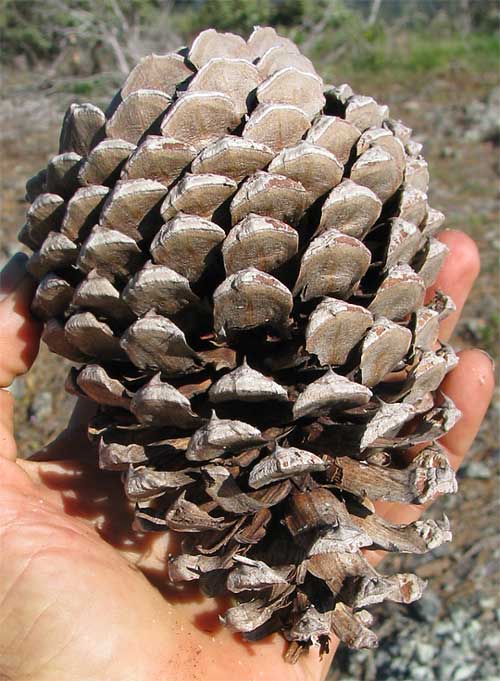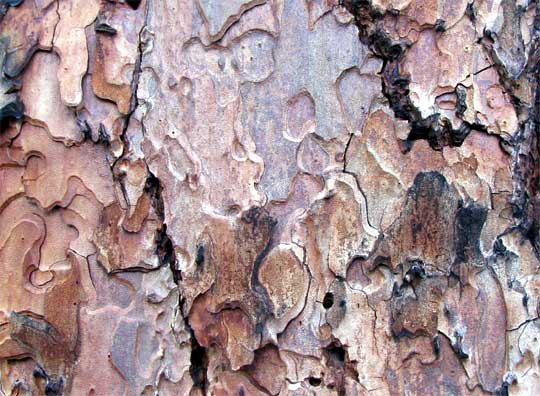Excerpts from Jim Conrad's
Naturalist Newsletter
from the April 26, 2009 Newsletter, issued from the Siskiyou Mountains west of Grants Pass, Oregon:
A PINEAPPLE-SMELLING PINE
The main pine in the woods around us is the big Ponderosa Pine. During this week's hike when I came to ridges where the forest thinned out or opened into the Serpentine barrens I told you about a while back, a new pine appears. In appearance it's a lot like the Ponderosa, except that there's a shiny, grayish cast to its needles and its cones are larger. You can see this pine in a nearby ridge-top serpentine barren below:

That's the Jeffrey Pine, PINUS JEFFREYI, distributed from here in southwest Oregon south through much of California, mainly in the Sierra Nevadas, to Baja California in Mexico. Over most of its distribution it's considered a high altitude species. Its Wikipedia page says that it grows from 1500-2000 meters (4900- 6600 feet) here in the northern part of its range, but the trees in the picture are growing at about 460 meters (1500 feet). The USDA Silvics Manual further reports the species at 183 m (600 ft) in Douglas County, Oregon.

Above you see one of its large cones. In the photograph's lower right corner you can see that each woody cone scale is tipped with an incurved prickle. Closely related Ponderosa Pine cone scales also bear prickles but they don't curve backward. The barks on mature trees of both Jeffrey and Ponderosa Pines are distinctive: Their bark exfoliates in scales fitting together like jigsaw-puzzle pieces. You can see the Jeffrey's bark below:

When I checked out Jeffrey Pine on the Internet I found yet another difference between it and Ponderosa Pine: Ponderosas smell of pine resin the way a pine is supposed to, but Jeffrey Pines have a scent variously described as reminiscent of vanilla, lemon, pineapple, violets, or apples.
In 2011 I find this note on Wikipedia's Resin Page, where they speak of the early days of the resin distillation industry:
Some resin distilleries in California exploded because they mistook Jeffrey Pine for the similar but terpene-producing Ponderosa Pine. At the time the two pines were considered to be the same species of pine; they were only classified as separate species in 1853.
Taking the pictures I hadn't bothered to smell the tree but this note so intrigued me that the next day I hiked back upslope to take a whiff. Three feet from the tree's trunk I smelled it: Pineapple. Maybe it wouldn't have been so fragrant if beetles hadn't been burrowing into its trunk causing sap leakage, for when I smelled of the bark itself it just smelled like dry bark. The pineapple odor derives from a volatile (it evaporates) component in the resin mostly composed of a chemical called n-heptane, much used in the world's chemical laboratories because it is a "totally non-polar solvent." A main source of n-heptane is distilled from the resin of Jeffrey Pine.
Usually resin oozing from wounds in pine tree trunks harden into yellowish, pea-sized droplets. Backwoodsy folks in Mississippi have taught me to plop such "rosin pills" into my mouth from time to time because of their medicinal value as a general pepper-upper. I did that at the Jefferson Pine's trunk and was surprised that the pill hardly tasted of turpentine at all, but rather had a mild, fruity flavor. Even more surprising was how long the softened gum lasted, sticking to my teeth much more tenaciously than average pine resin. Even after a lot of picking and brushing of teeth the gum remained, and disappeared only the next morning, dissolved by breakfast's mugs of hot water.